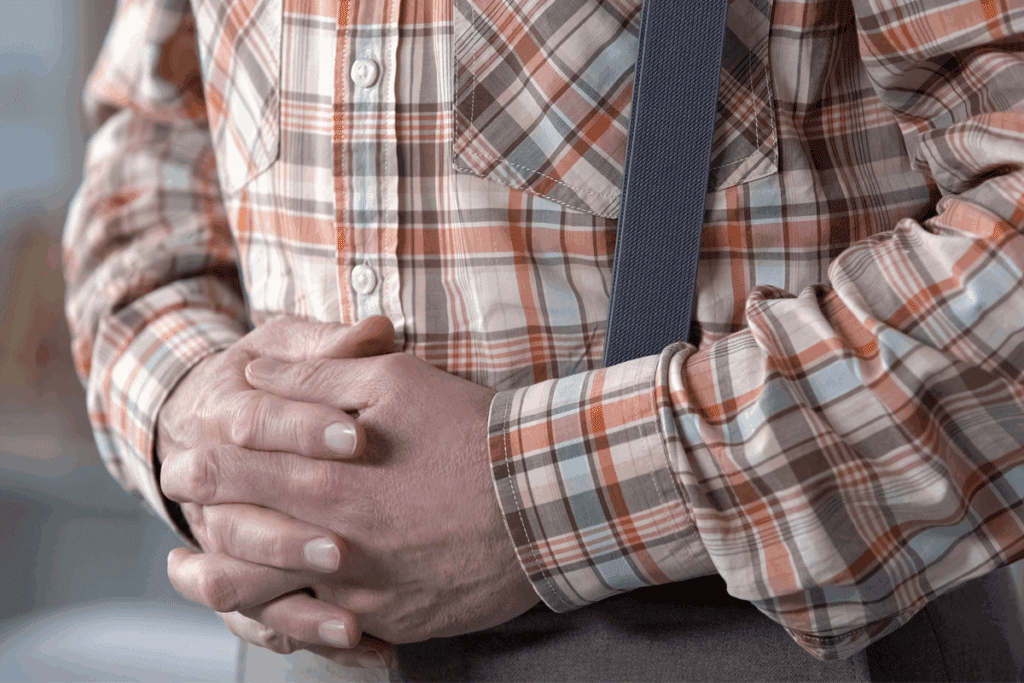Last Updated on November 26, 2025 by Bilal Hasdemir

A fat-containing inguinal hernia happens when fatty tissue bulges through a weak spot in the inguinal canal. This usually shows up as a bulge in the groin. It can cause discomfort or problems with digestion. It’s important to know what causes and symptoms it has.Learn fat containing inguinal hernia causes, symptoms, and when it commonly occurs in adults.
Inguinal hernias occur when tissue pushes through a weak spot in the abdominal wall. This happens near where the abdomen meets the thigh. At Liv Hospital, patients get care based on the latest research and a focus on the patient. This ensures they understand their condition clearly and confidently.

Fat containing inguinal hernias have their own unique features. They happen when tissue, like fat or part of the intestine, bulges through a weak spot in the abdominal wall or groin area.
Inguinal hernias occur when tissue bulges through a weak spot in the abdominal wall. This weak spot is in the inguinal canal, which is in the groin area. Normally, this canal has blood vessels and nerves. But with an inguinal hernia, tissue can pass through.
The anatomy of inguinal hernias involves the layers of the abdominal wall and the inguinal canal. The abdominal wall has muscles and connective tissue. Weaknesses in these layers can cause hernias.
Fat containing inguinal hernias are different from other hernias. They involve fatty tissue, not intestine. This difference is key for diagnosis and treatment.
These hernias have unique symptoms and need specific management. It’s important for healthcare providers to understand these differences to give the right care.
Key characteristics of fat containing inguinal hernias include:

It’s important to know how common inguinal hernias are. They are a big deal in public health. Knowing this helps both patients and doctors.
Inguinal hernias make up about 75% of all hernias. This shows how common they are. It’s key for everyone to understand this.
Many things can cause inguinal hernias. These include being born with them, physical strain, and aging. Because of this, doctors do a lot of hernia repairs every year.
Men and women face different risks for inguinal hernias. Men have a 27% lifetime risk. Women have a much lower risk of 3%. This difference comes from how men and women are built and the risks they face.
This difference means we need to focus on preventing hernias in men. Knowing this helps us find better ways to diagnose, treat, and prevent hernias.
Fat-containing inguinal hernias can happen for many reasons. These include being born with weak spots and getting hurt from physical activities. Knowing why they happen helps in preventing and treating them.
Being born with weak spots in the abdominal wall is a big reason for inguinal hernias. These spots can cause hernias later in life. The abdominal wall has muscles and tissues that can be weak, mainly in the inguinal canal area.
Congenital Conditions: People born with weak abdominal walls are more likely to get inguinal hernias. This risk can get worse with age and physical strain.
Heavy lifting and strenuous activities are also big causes of inguinal hernias. Doing things that involve lifting heavy things, bending, or hard exercise can put extra pressure on the abdominal wall. This can lead to hernias.
Occupational Hazards: Jobs that need heavy lifting or lots of physical work increase the risk of inguinal hernias. This includes jobs in construction, manufacturing, and other hard jobs.
Other things that can make inguinal hernias more likely include being overweight, getting older, and having chronic conditions that make the belly press harder. These things can make the abdominal wall weaker over time. This makes it more likely to get hernias.
| Cause | Description | Risk Factors |
| Congenital Weaknesses | Present at birth, leading to possible hernias later in life. | Family history, genetic predisposition. |
| Physical Strain | Heavy lifting and strenuous activities. | Occupational hazards, intense physical exercise. |
| Other Factors | Obesity, aging, chronic conditions. | Poor physical condition, chronic coughing, constipation. |
Several factors can increase your chance of getting a fat-containing inguinal hernia. Knowing these can help you prevent it and get help when needed.
Being overweight is a big risk for getting a fat-containing inguinal hernia. Extra weight strains the abdominal muscles, making hernias more likely. Keeping a healthy weight with a good diet and exercise can lower this risk.
A study found that obesity raises the risk of inguinal hernias, more so in women. The extra weight increases pressure inside the belly, which is thought to be a big factor.
As we get older, our abdominal wall tissues get weaker. This makes us more likely to get a hernia. Age-related changes include losing muscle and elasticity, which can cause a hernia.
Research shows that the risk of inguinal hernias goes up after 40. This is because muscles and tissues naturally weaken with age.
Pregnancy and childbirth are big risks for women to get a fat-containing inguinal hernia. The pressure inside the belly during pregnancy and the strain of childbirth can weaken the abdominal wall.
“Pregnancy is a well-known risk factor for inguinal hernias due to the increased pressure on the abdominal wall and the hormonal changes that affect tissue strength.”
If your family has a history of hernias, you might be more likely to get one too. The genes we inherit can affect how strong our abdominal tissues are.
| Risk Factor | Description | Impact |
| Obesity | Excess weight increases strain on abdominal muscles | High |
| Age | Weakening of abdominal tissues over time | Moderate to High |
| Pregnancy | Increased intra-abdominal pressure and hormonal changes | High |
| Family History | Genetic predisposition affecting tissue strength | Moderate |
Knowing these risk factors can help you take steps to lower your chance of getting a fat-containing inguinal hernia. This includes living a healthy lifestyle, knowing your family’s medical history, and getting medical advice if you notice symptoms.
It’s important for patients to know the signs of fat-containing inguinal hernias. These signs can be seen, felt, or noticed in digestion. Knowing these symptoms helps in getting the right medical care.
A bulge in the groin is a common sign of a fat-containing inguinal hernia. This bulge gets bigger when you cough, strain, or stand up.
People with these hernias often feel discomfort or heaviness in their groin. This feeling can be mild or very bad. It gets worse with more activity.
Some may also feel bloated or nauseous. This is more common with big hernias or if intestines are involved.
Seek medical help right away for severe pain, vomiting, or fever. These could mean a serious problem like the hernia getting stuck or cut off.
Getting medical help fast is key to avoiding serious issues.
Inguinal hernias with fat are different from others. Knowing this helps doctors figure out the best treatment. There are various types of these hernias, each with its own challenges.
These hernias happen on both sides of the groin and have fat. They are small. Finding them can be tricky because they look the same on both sides.
Many people get a small hernia on the left side with fat. The left side is more likely because of how the body is built. Knowing this helps doctors treat it better.
Right lower abdominal hernias are less common but harder to diagnose. The fat inside makes them tricky to manage. Getting the right diagnosis is key to treating them well.
Here’s a table that shows the different types of hernias based on where they are and how big they are:
| Type of Hernia | Characteristics | Diagnostic Considerations |
| Small Bilateral | Occurs on both sides, small in size, contains fat | Potential for symmetrical presentation complicating diagnosis |
| Small Left-Sided | Occurs on the left side, small, contains fat | Anatomical and physiological factors contribute to higher incidence on the left |
| Right Lower Abdominal | Occurs on the right lower abdomen, contains fat | Unique diagnostic challenges due to location and fat content |
Doctors need to know about these different hernias to give the right care. The fat inside makes them harder to diagnose and treat.
Age is a big factor in getting fat containing inguinal hernias. It affects people at different ages. Knowing when these hernias are more likely to happen helps in preventing and treating them.
Inguinal hernias, including those with fat, can show up in babies. This is because of weak spots in the belly wall they’re born with. These hernias might be there from birth or start early in childhood.
Preemies are more likely to get these hernias. This suggests a link between being born early and hernia risk.
Key facts about congenital and infant hernias include:
In adults, fat containing inguinal hernias come from many things. This includes hard work, getting older, and lifestyle choices. People who lift heavy, cough a lot, or are overweight are more at risk.
The risk factors for adult-onset hernias include:
The chance of getting fat containing inguinal hernias goes up after 40. This is because the belly muscles and tissues get weaker with age.
Age-related risk patterns:
| Age Group | Risk Factors |
| Infants | Congenital weaknesses, prematurity |
| Adults (40+ years) | Aging, physical strain, obesity |
To diagnose fat-containing inguinal hernias, doctors use a mix of physical checks and advanced scans. Getting the diagnosis right is key for good treatment and avoiding problems.
First, doctors do a detailed check-up to spot hernias. They use methods like feeling the area and the Valsalva maneuver. Palpation is when they feel the groin for bulges. The Valsalva maneuver makes the patient cough or strain to see the hernia better.
The Valsalva maneuver is very helpful because it raises pressure inside the belly. This makes it easier to find hernias that aren’t easy to see or feel. For people with hernias on both sides, checking both groins is important.
Modern scans are also key in diagnosing hernias. Ultrasound is often the first choice because it’s safe and shows things in real-time. It can tell if there’s a hernia, how big it is, and what’s inside.
Sometimes, more scans are needed. MRI or CT scans give detailed pictures of the hernia and the area around it. This helps doctors plan surgery if needed.
“Imaging techniques not only help in diagnosing inguinal hernias but also in planning the appropriate treatment strategy, even for complex or recurrent cases.”
It’s also important to rule out other conditions that might look like hernias. Things like inguinal lymphadenopathy, lipomas, or varicoceles can look similar. Doctors use both physical checks and scans to make sure.
Getting the right diagnosis for hernias, big or small, is vital for treatment. By using physical checks, scans, and careful diagnosis, doctors can create a treatment plan that fits each patient’s needs.
Managing inguinal hernias that contain fat needs a plan made just for you. This plan considers your health and the hernia’s details. The treatment choice depends on the hernia’s size, your symptoms, and your health.
For small, painless, or slightly painful hernias, watching and waiting might be best. This method includes:
For big, painful, or growing hernias, surgery is often needed. There are different surgeries:
After surgery, caring for yourself is key. You should:
Choosing between treatment and watching and waiting depends on several things. These include the hernia’s size, symptoms, and your health. Watchful waiting is good for small, painless hernias. But, surgery is usually needed for bigger or painful ones.
In summary, treating hernias with fat needs a detailed plan. This plan looks at your health and the hernia’s details. Knowing your options helps you make the best choice for your care.
Living with a fat containing inguinal hernia means making big lifestyle changes. It’s important to know what causes inguinal hernias to prevent them.
To avoid inguinal hernia, keep a healthy weight. Too much body fat can strain the abdominal wall. Also, don’t lift heavy things and manage conditions like coughing or constipation.
Knowing the risks and taking steps to prevent them can lower your chance of getting an inguinal hernia. This proactive approach is essential for managing and living with inguinal hernia.
A fat-containing inguinal hernia happens when fatty tissue bulges through a weak spot in the abdominal muscles in the groin area.
Inguinal hernias often come from a mix of genetic weaknesses, physical strain, and heavy lifting. Obesity and age also play a role.
You might see a bulge in the groin, feel discomfort or heaviness, and have digestive issues like bloating. Symptoms can get worse with activity or straining.
Inguinal hernias are quite common, making up about 75% of all hernias. Men are more at risk, with a 27% lifetime chance compared to 3% for women.
Some risks can’t be avoided, but staying at a healthy weight, avoiding heavy lifting, and managing chronic coughing or constipation can help lower your risk.
Doctors usually diagnose with a physical exam. Imaging tests like ultrasound or CT scans might also be used to confirm the hernia.
Treatment can be conservative, like monitoring and lifestyle changes, or surgery to repair the hernia. This depends on the severity and size of the hernia.
Inguinal hernias can happen at any age. Infants may get them due to birth defects, and adults due to age and other factors.
Yes, there are different types based on location and content. Examples include small bilateral, small left-sided, and right lower abdominal hernias.
Risk factors include obesity, age, pregnancy, family history, and genetic predisposition. These increase your chance of getting a hernia.
References
Khalil, H. M., et al. (2021). Biliary leakage following cholecystectomy: A prospective population study. Journal of Research in Medical and Dental Science, 9(5), 289-296. Retrieved from https://www.jrmds.in/articles/biliary-leakage-following-cholecystectomy-a-prospective-population-study-84919.html
Subscribe to our e-newsletter to stay informed about the latest innovations in the world of health and exclusive offers!